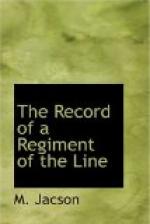On August 9th the army continued its advance. On leaving Amersfoort, a bad drift with a steep climb of half a mile on the further side was met with, and the baggage was formed into two columns. This was assisted up the hill by two companies of the Regiment, Sir Redvers Buller personally superintending. Klippaal Drift was reached late in the afternoon after a difficult march of ten miles.
General Buller’s army was now on the high veldt in winter time. The cold was intense, especially at night, when there were several degrees of frost. Owing to the intense cold, two men of the Rifle Brigade died from exposure during the night.
[Illustration: The Baggage of General Buller’s Army Crossing Beginderlyn Bridge]
On the following day the force continued its march to Beginderlyn Bridge. This was found intact, and there was no opposition, and the march was resumed on the 11th as far as Kleinfontein. On August 12th Ermelo was occupied, and a few of the leading Boers belonging to the place surrendered.
So far, and until Twyfelaar was reached, Buller’s army received little or no opposition from the Boers. Chris. Botha, who had occupied Amersfoort, had retired east after evacuating that place, and was marching parallel to the British force and at a distance of about ten miles on its right flank. They were evidently watching Buller, probably thinking that he would turn east towards Piet Retief, where almost all their stock, sheep, and cattle had been driven, the mountainous and difficult country there being suitable for its concealment and protection.
The main body of the Boers was concentrated between Belfast and Machadodorp, north-east of Twyfelaar, in a country eminently suited for what was considered their final effort. The valley of the Komati River was exceedingly difficult country for the British army to operate over. The Boers to the end of the war were very fond of this country, and it was there, or in the vicinity towards Lake Chrissie, that several engagements took place later on, during the guerilla stage of the war, not always in favour of the British.
The town of Ermelo, which the Regiment was destined to see again on several future occasions, was left on August 13th, on the evening of which day the force reached Klipfontein. The Regiment, being rear-guard, did not reach its bivouac till after dark. Witbank was reached the following day, and communication was opened up with General French’s column, fifteen miles to the north-west. Carolina could be seen eight miles away to the north-east.
The force marched next day to Twyfelaar, and here a halt was made till August 21st, in order to allow of Lord Roberts’s army, which was advancing east from Pretoria along the Lorenzo Marques railway, joining hands with General Buller’s army.
The rear-guard of the force was attacked by the Boers on August 21st on its march from Twyfelaar to Van Wycks Vlei. The Gordon Highlanders lost nine killed and eight wounded, and the Liverpool Mounted Infantry eight killed.




